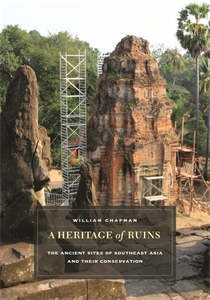A Heritage of Ruins: The Ancient Sites of Southeast Asia and Their Conservation
- About the Book
-
The ancient ruins of Southeast Asia have long sparked curiosity and romance in the world’s imagination. They appear in accounts of nineteenth-century French explorers, as props for Indiana Jones’ adventures, and more recently as the scene of Lady Lara Croft’s fantastical battle with the forces of evil. They have been featured in National Geographic magazine and serve as backdrops for popular television travel and reality shows. Now William Chapman’s expansive new study explores the varied roles these monumental remains have played in the histories of Southeast Asia’s modern nations.
Based on more than fifteen years of travel, research, and visits to hundreds of ancient sites, A Heritage of Ruins shows the close connection between “ruins conservation” and both colonialism and nation building. It also demonstrates the profound impact of European-derived ideas of historic and aesthetic significance on ancient ruins and how these continue to color the management and presentation of sites in Southeast Asia today. Angkor, Pagan (Bagan), Borobudur, and Ayutthaya lie at the center of this cultural and architectural tour, but less visited sites, including Laos’s stunning Vat Phu, the small temple platforms of Malaysia’s Lembah Bujang Valley, the candi of the Dieng Plateau in Java, and the ruins of Mingun in Burma and Wiang Kum Kam near Chiang Mai in northern Thailand, are also discussed. All share a relative isolation from modern urban centers of population, sitting in park-like settings, serving as objects of tourism and as lynchpins for local and even national economies. Chapman argues that these sites also remain important to surrounding residents, both as a means of income and as continuing sources of spiritual meaning. He examines the complexities of heritage efforts in the context of present-day expectations by focusing on the roles of both outside and indigenous experts in conservation and management and on attempts by local populations to reclaim their patrimony and play a larger role in protection and interpretation.
Tracing the history of interventions aimed at halting time’s decay, Chapman provides a chronicle of conservation efforts over a century and a half, highlighting the significant part foreign expertise has played in the region and the ways that national programs have, in recent years, begun to break from earlier models. The book ends with suggestions for how Southeast Asian managers and officials might best protect their incomparable heritage of art and architecture and how this legacy might be preserved for future generations.
- About the Author(s)
-
William R. Chapman, Author
William Chapman is director of the Graduate Program in Historic Preservation and professor and chair in the Department of American Studies at the University of Hawai‘i at Mānoa. Educated at Columbia and Oxford (M.S. and D.Phil), he specializes in architectural recording, the history of historic preservation, and materials conservation. Widely published in scholarly journals, he has also written on subjects ranging from the historic Volcano House Hotel in Hawai‘i to the Wright Brothers National Memorial at Kitty Hawk, North Carolina. Married and the father of two daughters and two stepchildren, he lives in Honolulu and in Bangkok.
- Reviews and Endorsements
-
- Overall, the book is a most valuable contribution to the comparative study of the material expressions of Southeast Asian cultures, and specifically the history of conservation and the role and work of UNESCO, other international agencies, and local institutions in this endeavor. It is beautifully illustrated; there is a substantial bibliography and a helpful index. It will undoubtedly become an important reference work. Indeed, an abbreviated version of the book in a lighter, more easily carried paperback form would sell very well in the tourist and travel market in airport bookshops. Chapman manages to combine scholarship with an eye on the interests of a popular readership. I am delighted to have a copy on my bookshelf.
—Anthropos - This is a useful book in many respects. While full of history, each chapter follows a consistent, forward framework. For the uninitiated in heritage questions, the book requires little technical pre-knowledge yet introduces the reader to real and contemporary questions facing site managers and heritage practitioners, national governments and world bodies. With its rich history and thought provoking discussion, these issues should also concern the conscientious traveler when he or she next visits one of these awe-inspiring edifices of human civilization.
—Akagawa Nasuko, The University of Western Australia - Of interest to archaeologists and conservationists working in Southeast Asia; should appeal widely to scholars pursuing research in the burgeoning world of heritage studies. Summing Up: Highly recommended.
—E. R. Swenson, University of Toronto - William Chapman has produced a remarkably cogent and well balanced portrayal of an emblematic Southeast Asian building type—the monumental ruin. He impressively presents the full array of influences—natural context, social history, and heritage protection legislation—that shape the existence of these architectural remains, and comments eloquently and insightfully on how they influence those who experience them today.
—John H. Stubbs, author of Time Honored: A Global View of Architectural Conservation, and director of the Preservation Studies program, Tulane University
- Overall, the book is a most valuable contribution to the comparative study of the material expressions of Southeast Asian cultures, and specifically the history of conservation and the role and work of UNESCO, other international agencies, and local institutions in this endeavor. It is beautifully illustrated; there is a substantial bibliography and a helpful index. It will undoubtedly become an important reference work. Indeed, an abbreviated version of the book in a lighter, more easily carried paperback form would sell very well in the tourist and travel market in airport bookshops. Chapman manages to combine scholarship with an eye on the interests of a popular readership. I am delighted to have a copy on my bookshelf.
- Supporting Resources
-





